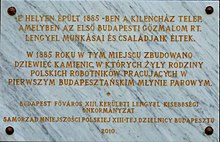This article has multiple issues. Please help improve it or discuss these issues on the talk page. (Learn how and when to remove these messages)
|
 Ethnic Polish minority self-government locations in Hungary, as of 2010 Ethnic Polish minority self-government locations in Hungary, as of 2010 | |
| Total population | |
|---|---|
| 7,001 (2011, census) | |
| Regions with significant populations | |
| Budapest | |
| Related ethnic groups | |
| Polish diaspora |
Poles in Hungary form a population of 7,001, according to the 2011 census, and Polish presence in Hungary dates back to the Middle Ages.
The Poles are organized into 46 ethnic Polish minority self-governments, adjacent to local Hungarian authorities, and over 30 Polish organizations (as of 2023).
History
Two Polish dukes of the Piast dynasty were appointed Catholic bishops in medieval Hungary, i.e. Bolesław of Toszek was the Archbishop of Esztergom in 1321–1328, and Mieszko of Bytom was the Bishop of Nyitra in 1328–1334 and Bishop of Veszprém in 1334–1344.

Some 3,000 Poles formed the Polish Legion, which fought in the Hungarian Revolution of 1848, and Polish general Józef Bem became a national hero of Hungary.
After the fall of the Polish January Uprising of 1863–1864 in the Russian Partition of Poland, about 4,000 Polish refugees were received in Hungary. In times of Austria-Hungary some Poles from the Austrian Partition of Poland came to Hungary to work.
An indigenous Polish population inhabited the northernmost counties of Árva, Szepes, Sáros and Trencsén, which also formed part of Poland in the past, and the two former, in the historic regions of Orava and Spisz, are now divided between Slovakia and Poland. In Orava there were 24,196 Poles according to data from 1864, in Spisz the Polish population was estimated between 27,000 to 37,000 in 1880, and in Trencsén County it was estimated up to 34,000 in 1892. In Šariš, there were two Polish villages Hradzisko and Szandel.
Some 20,000 Poles, including Polish Jews, lived in Hungary in the 1920s, mostly in Budapest and its environs.
World War II
Following the joint German-Soviet invasion of Poland, which started World War II in September 1939, over 100,000 military and civilians, including children, fled from Poland to Hungary.

The Hungarian authorities resisted German pressure to close the Polish Institute in Budapest, a Polish cultural institution established before the war. In order to do so, the Hungarians referred to the autonomy of the Royal Hungarian Pázmány Péter University, whose employee was the director of the Institute, Professor Zbigniew Załęski. The Institute was a place where Polish culture was freely and legally cultivated at a time when it was brutally suppressed in German- and Soviet-occupied Poland and Europe. The Institute also published Polish literature and press, and in addition to cultural activities, it helped Polish refugees and civilians in Hungary, and gave Hungarian language lessons to Poles so that they could study at Hungarian universities. It was closed only in 1944 due to the German occupation of Hungary, to be reopened after the war in 1951.
Dozens of Polish elementary schools were established in Hungary, 27 of which existed throughout the entire stay of Poles in Hungary, as well as high schools, including the significant Gymnasium and Lyceum in Balatonboglár, which functioned until the German invasion of Hungary in 1944.
In 1944, Hungarians gave shelter to Poles who escaped the Ukrainian-perpetrated massacres in German-occupied southeastern Poland to Hungary, and also facilitated further escapes.
Notable people
- Richeza of Poland, Queen of Hungary (1013–1075), Queen consort of Hungary
- Fenenna of Kuyavia (c. 1276–1295), Queen consort of Hungary
- Bolesław of Toszek (c. 1276–1328), Archbishop of Esztergom
- Maria of Bytom (1295–1317), Queen consort of Hungary
- Mieszko of Bytom (c. 1305–1344), Bishop of Nyitra and Veszprém
- Elizabeth of Poland, Queen of Hungary (1305–1380), Queen consort of Hungary
- Stibor of Stiboricz (c. 1348–1414), aristocrat, close friend of King Sigismund of Hungary
- Isabella Jagiellon (1519–1559), Queen consort of Hungary
See also
References
- ^ Wyszyński, Robert; Leszczyński, Karol (2023). Atlas Polaków na świecie (in Polish). Warszawa: Instytut Pokolenia. p. 69. ISBN 978-83-968580-3-0.
- Polacy to nasi przyjaciele. Węgrzy i powstanie warszawskie 1944 (in Polish and Hungarian). Warszawa: Instytut Pamięci Narodowej, Węgierski Instytut Kultury w Warszawie. 2017. pp. 16, 21. ISBN 978-83-8098-246-8.
- Słownik geograficzny Królestwa Polskiego i innych krajów słowiańskich, Tom XV. Część II (in Polish). Warszawa. 1902. p. 414.
{{cite book}}: CS1 maint: location missing publisher (link) - Słownik geograficzny Królestwa Polskiego i innych krajów słowiańskich, Tom XI (in Polish). Warszawa. 1890. p. 117.
{{cite book}}: CS1 maint: location missing publisher (link) - Słownik geograficzny Królestwa Polskiego i innych krajów słowiańskich, Tom XII (in Polish). Warszawa. 1892. p. 470–471.
{{cite book}}: CS1 maint: location missing publisher (link) - Słownik geograficzny Królestwa Polskiego i innych krajów słowiańskich, Tom XI (in Polish). Warszawa. 1890. p. 805.
{{cite book}}: CS1 maint: location missing publisher (link) - Żukow-Karczewski, Marek (1989). "Polonia zagraniczna w czasach II Rzeczypospolitej". Życie Literackie (in Polish). No. 33 (1952). p. 10.
- ^ Ney-Krwawicz, Marek (2011). "Tułacze dzieci i ich szkoły 1939-1948". Niepodległość i Pamięć (in Polish) (18/2 (34)). Muzeum Niepodległości w Warszawie: 88. ISSN 1427-1443.
- ^ "Historia". Instytut Polski w Budapeszcie (in Polish). Archived from the original on 19 March 2019. Retrieved 10 January 2024.
- Bereza, Tomasz (2020). "Węgrzy wobec eksterminacji ludności polskiej przez nacjonalistów ukraińskich". Biuletyn IPN (in Polish). No. 1–2 (170–171). IPN. pp. 130–131. ISSN 1641-9561.
| Polish diaspora and Polish minorities | |||||||||||||||||||
|---|---|---|---|---|---|---|---|---|---|---|---|---|---|---|---|---|---|---|---|
| Historical | |||||||||||||||||||
| Diaspora |
| ||||||||||||||||||
| See also | |||||||||||||||||||
| Ethnic groups in Hungary | |
|---|---|